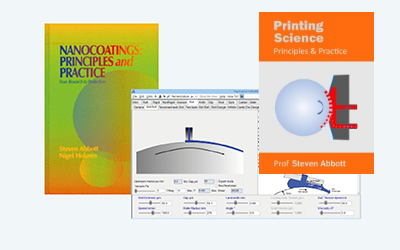Cup Viscosity Conversion
Quick Start
I can't troubleshoot a coating issue without knowing the viscosity. It is very frustrating to be told "It's 23s Zahn 2" as I have no idea what this is in real units. This is the 21st century; we shouldn't be using Zahn cups. But until things change, this is the best I could do to help myself and others.
Cup Viscosity Conversion
 Many printers/coaters measure their viscosity using cups with holes in the bottom by finding how many seconds it takes to empty the full cup (or, rather, for the flow to "break"). Different cups have different shapes and hole sizes and because times too short or too long are unsuitable, for any given viscosity there is an optimum cup with times in the 15-60s range. The size of the hole is in mm and a Zahn #4 means a Zahn cup with a 4mm hole.
Many printers/coaters measure their viscosity using cups with holes in the bottom by finding how many seconds it takes to empty the full cup (or, rather, for the flow to "break"). Different cups have different shapes and hole sizes and because times too short or too long are unsuitable, for any given viscosity there is an optimum cup with times in the 15-60s range. The size of the hole is in mm and a Zahn #4 means a Zahn cup with a 4mm hole.
I find it very annoying that in the 21st century such unscientific devices are used and get frustrated that no one (including me) has any idea what approximate viscosity in real units (i.e. mPa.s or cP as a convenient unit) is being used.
I say "approximate" for two reasons. First they are not accurate even when done properly (see below) and even less when they aren't cleaned properly between use, etc. Second, they assume Newtonian viscosity, so they tell you nothing about shear thinning.
An expert in the field has warned me that this app might add legitimacy to the use of these cups. I hope that is not the case! All I am doing is helping those, like me, who want to have some idea of what is going on when the only data available are measurements from these cups. Here you can choose from one of a few types of cup, specify your time in the 15-60s range and get an estimate of the viscosity in cP. Because these cups actually measure the kinematic viscosity in cSt (a denser liquid flows out faster), enter your estimated density to allow the conversion (cP=cSt*ρ).
If you have ever measured a real viscosity and compared it to a value from one of the "standard conversion tables" you will probably be surprised at the difference. In preparing this app I looked at many such tables and a 20s Zahn #2 cup viscosity varies from ~20-45cP depending on the table. One supplier said words to the effect of "We're not changing our cups to meet ASTM standards because our users would be confused between old and new cups."
For this app I used the simple formula η = K.t-C/t used by the Paul N. Gardner Co in their helpful Excel spreadsheet downloadable from Viscosity Cup Equivalent Wall Chart, where K and C are provided for the most popular cups.
According to the excellent book The Printing Ink Manual by Robert Leach, the single-operator accuracy of these cups is in the 5-10% range and the multi-operator accuracy in the 10-30% range, with ISO cups being best and Zahn cups being worse. Those errors seem rather large to me!


